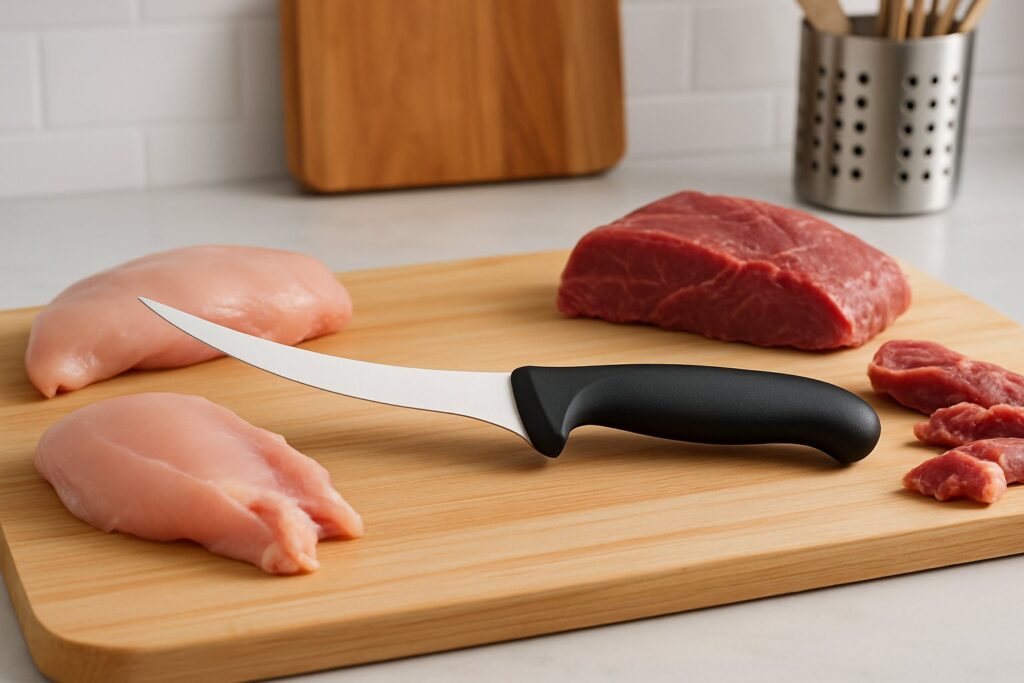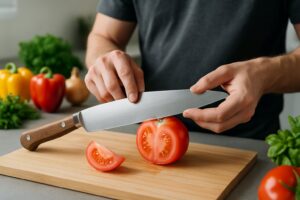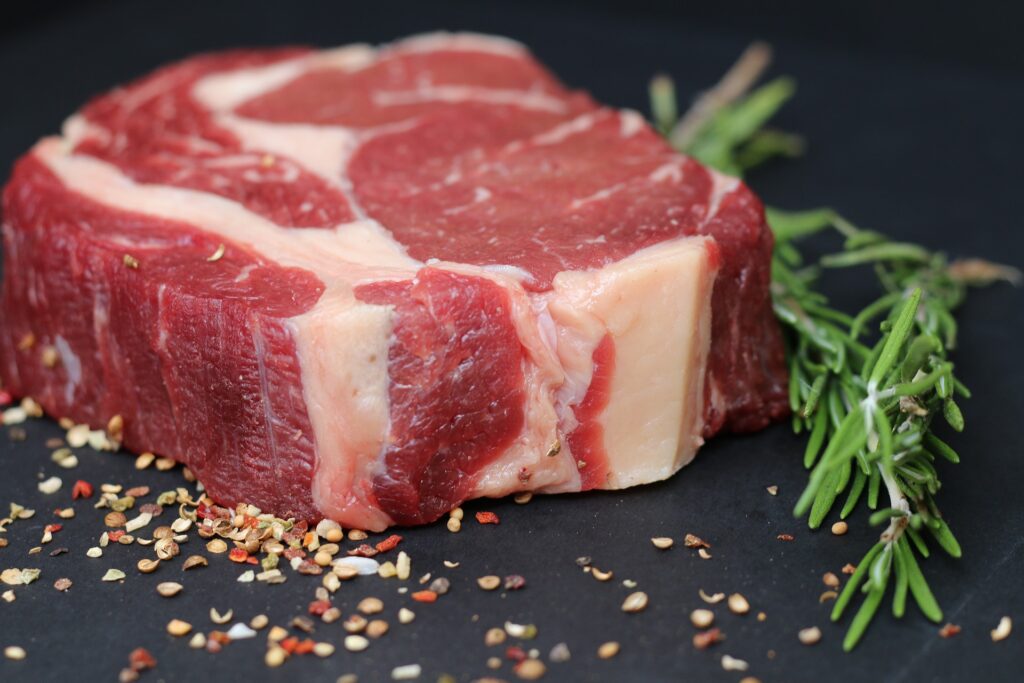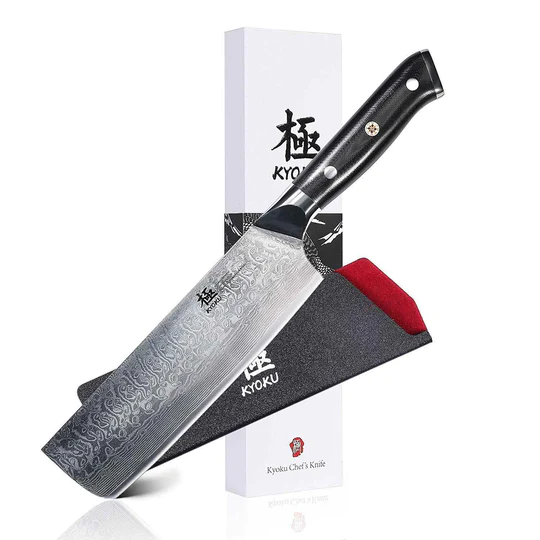


In the kitchen, it’s all too easy to stick to only using a single knife. But as any chef will tell you, you are better off using the right tool for the right job. Nowhere else is this more clear than in the case of the boning knife.
Picking a good boning knife comes down to matching it with what you actually do in the kitchen. You want a boning knife with a flexible, curved blade for precise cuts around bones and joints.
It helps to know how a boning knife differs from a butcher’s knife or a meat cleaver. Each knife has its own job in the kitchen.
Boning knives need enough flexibility to work around bones, while butcher’s knives and meat cleavers are built for power.
| Knife Type | Blade Length | Blade Breadth | Blade Flex | Typical Use |
|---|---|---|---|---|
| Boning Knife | 5–6.5 inches | Thin to medium | Flexible to semi-stiff | Removing bones, trimming meat |
| Butcher Knife | 6–14 inches | Medium to thick | Stiff | Cutting large pieces of meat |
| Meat Cleaver | 6–12 inches | Thick and heavy | Very stiff | Splitting bones, heavy chopping |
Boning knives come in different blade stiffness, shapes, and styles depending on where they’re made. These differences show up when you’re trimming meat, deboning, or working with chicken or fish.
Knowing what sets different boning knives apart will help you pick one that best fits your needs.
Stiff blades don’t bend much, so they’re great for working around big, tough bones—think beef or pork. The extra rigidity gives you more power and accuracy when you’re separating meat from bone.
Flexible blades bend more easily, which is perfect for following the curves of small bones in poultry or fish. This lets you remove meat without mangling it.
If you mostly do heavy work, go stiff. For delicate, detailed jobs, flexible is the way to go. Most boning knives fall between 5 and 6 inches in length.
Curved blades are shaped to follow the natural lines of poultry or small game bones. They’re handy for skinning and making smooth, sweeping cuts.
Straight blades give you precise, clean slices and are easier to sharpen. They come in handy for bigger cuts or when you need straight lines, like trimming fat.
Which one you pick really depends on what you’re cutting and your personal style. Some boning knives mix in a slight curve for more versatility.
Western boning knives are usually stiffer and heavier. You’ll often see thicker steel and bigger, ergonomic handles for a solid grip.
Japanese boning knives have thinner, sharper, and more flexible blades. They’re fantastic for detail work, especially with fish or poultry. The Honesuki, for example, is known for its precision and feather-light feel.
Western knives lean toward durability, while Japanese knives focus on agility and sharpness. It’s really about what you cook most and what feels right in your hand.
The best boning knives balance precision, durability, and comfort. They need to be sharp enough to work close to bones, and either stiff or flexible depending on your tasks.
Blade size, material, and handle design all play a part in how well the knife works for you.
Blade material affects sharpness, how long the edge lasts, and whether it rusts. High-carbon stainless steel is a popular pick because it holds an edge and resists rust.
Softer steel sharpens more easily but can dull faster. Harder steel keeps its edge longer but might chip if you’re rough with it. The blade should be finely ground and polished so it glides through meat.
For delicate work, go for a thin, flexible blade. If you’re tackling tough meat, a stiffer blade is better. Most quality blades have an angle above 15 degrees per side, which is a sweet spot for sharpness and durability.
Most boning knives have blades between 5 and 6.5 inches. Shorter blades give you more control around bones and joints—super handy for detail work.
Thinner blades are more flexible, perfect for filleting or removing skin. Thicker blades add strength for tough cuts, but you lose some maneuverability.
The blade should be narrow enough to get into tight spots, but strong enough not to snap. The right length and thickness really depends on what you cut most often.
The handle needs to fit your hand well, or you’ll feel it after a while. Wood, plastic, or composite handles all have their own feel and grip.
Ergonomic handles with a gentle curve help you keep control and avoid slipping. A textured surface or finger guard is a plus, especially if things get messy.
Balance matters—a well-balanced knife feels natural and makes accurate cuts easier. Some handles are riveted for strength, while others are molded to prevent gaps where gunk can collect.
The right boning knife depends on the meat and the level of precision you need. Blade flexibility, length, and shape all change how well the knife handles different textures and bones.
Getting these details right helps you match the knife to the job.
Meat boning knives usually have a narrow, firm blade—think 5 to 6 inches. The blade’s got just enough flex to cut close to the bone without flopping around.
The tip is sharp and pointed for working around joints. You’ll often see a curved edge to follow the shape of ribs or legs. Handles are built for a solid grip, which you’ll want for tougher cuts.
Fish boning knives come with a thinner, more flexible blade, usually about 6 inches. This makes it easier to separate delicate flesh from tiny bones without ruining the texture.
The blade’s sharp, with a narrow point for precision. Its length lets you maneuver along curved fish bones, and a slightly longer handle helps when filleting.
Poultry boning knives are shorter—around 5 inches—with a super flexible blade for getting around small, tricky bones. That flex keeps you from tearing up the tender meat.
The tip is sharp and narrow, perfect for cutting around joints and cartilage. A comfy handle is a must, since you’re often working in tight spots.
This table highlights the key differences between boning knives, butcher’s knives, and meat cleavers, so you can figure out which one makes sense for your prep work.
If you’re picking a boning knife, you’ve got to think about sharpness, control, and safety. These things make sure the knife works well and keeps you safe while you’re trimming meat or fish.
Paying attention to details like these helps you avoid mistakes and cut more precisely.
Your boning knife needs to be really sharp to cut close to bones without tearing the meat. Sharpness means smoother, cleaner cuts and less waste.
High-carbon steel blades usually stay sharp longer, but they need more care to avoid rust. Stainless steel blades are more resistant to corrosion but might dull a little faster. Regular sharpening with a honing steel or stone keeps your knife working its best.
A balanced knife feels steady and comfortable in your hand. Good balance helps you avoid hand fatigue, especially during long prep sessions.
Control comes down to the knife’s weight and handle shape. Lighter, flexible knives are better for detailed jobs like filleting. A comfortable handle—whether it’s wood, plastic, or composite—makes a big difference, especially when your hands are wet.
Safety features help lower the risk of cuts. A sturdy finger guard or bolster between the blade and handle stops your hand from sliding onto the blade.
Non-slip handles give a better grip, especially if your hands are wet or greasy. Some knives have textured or rubberized handles for extra hold.
Always cut away from your body and keep knives sharp—dull blades can slip and cause accidents.
When you’re picking a boning knife, a few brands really stand out. Shun knives get a lot of praise for their sharpness and precision, with blades that are usually pretty stiff—nice for delicate tasks, but maybe a bit much for beginners.
Wusthof boning knives strike a good balance between flexibility and strength. Their blades hold an edge well and tackle tougher cuts, so they’re a solid pick if you want something durable without giving up control.
Zwilling boning knives combine sharpness with comfort. Their boning knives often have a slightly curved spine, which helps with smooth slicing around bones. They’re great for cooks who want versatility in the kitchen.
To keep your boning knife in good shape, pay attention to cleaning, sharpening, and storage. Proper care keeps the blade sharp and safe for precise work.
Wash the knife by hand after each use, using warm water and mild soap. Don’t soak it for long—water can damage both the handle and blade.
Dry it right away with a soft cloth to prevent rust. Skip the dishwasher; high heat and harsh detergents can ruin the blade and handle.
If your knife has a wooden handle, rub on some mineral oil now and then to keep it from drying out or cracking. Cleaning promptly also stops food from hardening on the blade, which can mess with cutting performance.
Sharpen your knife regularly to keep the blade keen. A whetstone or sharpening steel works best—just watch your angle and don’t press too hard, or you might damage the edge.
Flexible blades need a gentler touch than stiff ones, so adjust your sharpening technique accordingly.
Store knives in a wooden block, on a magnetic strip, or with a blade guard. This keeps the edge sharp and your hands safe.
Budget definitely matters when you’re picking out a boning knife. You’ll find them at all price points—some start around $40, while others go north of $200. Usually, you get what you pay for: pricier knives tend to have better blades and handles.
Look for a knife that balances cost and performance. Cheaper ones might be fine for occasional use, but they don’t always stay sharp or last long. Mid-range knives often have better steel and comfier handles, which is nice for home cooks and pros alike.
High-end knives use top-notch materials and offer great precision, though honestly, you don’t always need them for everyday tasks.
The right knife depends on what you’re cutting and how often. Flexible boning knives are great for poultry and fish, while stiff blades handle beef and pork. For more on blade types and flexibility, check out that ideal boning knife guide.

It’s worth thinking about where your boning knife’s materials come from. Ethical sourcing means suppliers follow fair labor practices and care about the environment. Brands that are open about their material sources are usually more trustworthy.
Look for wood handles with Forest Stewardship Council (FSC) authentication, or International Organization for Standardization (ISO) standards for sustainable production. These help make sure your knife is made with respect for people and the planet.
Eco-friendly knives might use recycled metals or wood from sustainable sources. Some companies also try to cut down on waste and energy use during production.
Ethical and sustainable knife making helps protect resources and workers’ rights. If you care about these issues, do a little research into the brands you’re considering.
Picking a boning knife comes down to sharpness, flexibility, and blade size. The best ones balance precision and durability. Prices vary a lot, but value usually depends on materials and blade design.
Victorinox boning knives get a lot of love for sharpness, light weight, and affordability. They pair a flexible blade with a comfy handle, making them a solid all-purpose pick for home cooks.
Blade flexibility matters depending on the meat. Stiff blades handle tough bones; flexible ones are better for delicate cuts.
Most blades are 5 to 6 inches long. A comfy, secure handle is important for safety and accuracy. Blade material affects sharpness and edge life. High-carbon stainless steel is popular for its performance and rust resistance.
Good boning knives have a sharp, narrow blade with a pointed tip to get around bones easily. Handles that are ergonomic and slip-resistant help you keep control, even when things get messy.
Durability and easy sharpening matter too. Reliable knives stay sharp longer and are simple to maintain.
Straight blades give you precise, straight cuts and are easier for some folks to control. Curved blades help you work around joints and odd-shaped bones, letting you move more smoothly.
Curved knives usually have a more pronounced upward sweep, which is great for trimming but might take some practice.

Pros often pick knives that balance flexibility and stiffness, depending on what they’re cutting. Japanese-style boning knives are favorites for their thin, sharp blades and precision.
Many chefs stick with high-quality brands that last and keep a sharp edge.
Victorinox knives feel lighter in your hand and offer more flexibility. They’re a solid pick for detailed or delicate work. Wusthof boning knives have more heft. They feel stiffer and give you extra confidence for tougher cuts.
Both brands keep their edges pretty well. Wusthof blades are a bit thicker, so you might find yourself sharpening them less often.

Knife Buzz offers independent product reviews on a wide range of knives used in the kitchen, home, and outdoors. We make it easy for you to find the right knife at the best price.